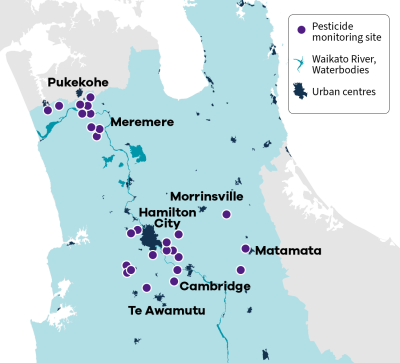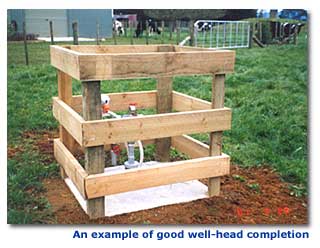Groundwater contaminants
We often take a plentiful supply of clean drinking water for granted.
Threats to our groundwater quality come from many sources,and contaminated groundwater can endanger people’s health and the environment. Many Waikato rural communities rely on groundwater for their water supply. Community groundwater supplies in the Waikato include:
- about 90 schools
- about 30 community supplies managed by district councils
- numerous motor camp supplies.
Types of groundwater contaminants
Contamination of groundwater usually happens gradually and can go unnoticed for some time. Most contaminants come from the ground surface, so shallow water table aquifers with thin soil cover are easily contaminated.
Contamination of groundwater can come from point sources (from specific locations) or non-point sources (from wider areas).
Point sources include:
- septic tanks, leaking effluent treatment ponds and landfills
- leaking underground fuel tanks and pipelines
- mines and waste tailings
- chemical storage areas and timber treatment sites
- waste disposal sites, such as offal holes.
Non-point sources include:
- pesticide and fertiliser applications
- agricultural land use
- application of wastes to land
- saltwater intrusion.
Learn more about the common groundwater contaminants in the Waikato region, below.
What can we do to protect groundwater quality?
Prevention is better than cure
It is much easier to prevent groundwater contamination than to try to fix it afterwards. Trying to clean up contaminated drinking water is very costly and often not practical.
By comparison, protecting source water costs very little and is a ‘common sense’ approach to safeguarding public health and the environment.
Community groundwater supplies must be registered with the Ministry of Health and monitored to see if they meet drinking water standards. The drinking water standards for New Zealand list maximum acceptable values for:
- microbial contaminants
- chemical contaminants
- ‘aesthetic’ values (relating to nuisance rather than health concerns, for example, staining).
What Waikato Regional Council is doing
Waikato Regional Council uses a range of methods to manage groundwater resources, including:
- Regulating activities likely to cause contamination, such as wastewater discharge.
- Making sure wells are properly constructed, completed and separated from likely sources of contamination.
- Educating the public (in partnership with health authorities and district councils) about ground water source protection and the need for appropriate land use near groundwater supplies.
- Working with industry to develop codes of practice and industry guidelines.
- Monitoring ground water quality, investigating issues and providing information to the public.
Supply owners
Supply owners or managers should develop risk management plans to protect groundwater drinking sources. These include:
- An assessment of how vulnerable the source water is to contamination.
- Prevention and restoration measures.
- Information for supply users on the risk of contamination.
- Ongoing monitoring and review.
What you can do
Communities can protect groundwater supplies by:
- Making sure wells are properly completed, sealed (including a concrete pad), and protected to prevent surface contamination.
- Storing chemicals away from wells.
- Registering supplies and monitoring water quality.
- Defining well-head protection areas.
- Documenting potential sources of contamination.
- Working with councils and advocating for appropriate land use restrictions.
- Developing and regularly reviewing risk management plans.
Well-head protection areas control certain land uses in the area contributing water (and potentially contaminants) to a groundwater supply. There are a number of methods which can be used to map well-head protection areas and we advise consulting a specialist hydrogeologist.

 Pesticide use in New Zealand has grown significantly in recent years. A total of 669 pesticides containing 302 different active ingredients were registered for use in New Zealand in 1995. The same year about 4,000 tonnes of pesticides were used across the country.
Pesticide use in New Zealand has grown significantly in recent years. A total of 669 pesticides containing 302 different active ingredients were registered for use in New Zealand in 1995. The same year about 4,000 tonnes of pesticides were used across the country. Remember, it is much easier to prevent groundwater contamination than to fix it later!
Remember, it is much easier to prevent groundwater contamination than to fix it later!
To ask for help or report a problem, contact us
Tell us how we can improve the information on this page. (optional)